
WebLetter 25
An Occasional Publication for the Home Boat Builder
Glen-L Marine Designs - 9152 Rosecrans Ave. - Bellflower, CA 90706
In this issue
- Builder update: Riviera
- Feedback: Sweet Caroline
- Designers Notebook - Center of Buoyancy
- Feedback: Marauder
- Feedback: Kingpin
- Feedback: Tubby Tug
- Recent email
GLEN-L Update
- Web site:
- As usual, the additions to the Project Registry and Customer Photos are too numerous to list. We have added an "Outboard Planing Boat Speed Chart" to the "How Fast?" page. If you have not yet seen the "How Fast?" page, there is a link from the bottom of the Boat Design Catalog contents page.
- Also, keep an eye on the contents pages of the various Design sections; there are links at the bottom of some pages giving additional information on hardware and design. More will be added as we have time and to answer your questions.
- We have also begun to add "Notes" links to the individual Design pages. There are not many yet (about 20), but we will be adding more, so it might pay to re-visit the pages if you are interested in a particular design. Most of the Notes that have been added are in response to specific inquiries. If there is a "Notes" link it will be under the "Photographs" link, about half-way down the design page.
- We have added additional entries to the Glossary (Useful Information and Suppliers) in answer to email suggestions.
- The "New" section has additional information about our current project, "Party Boat". See the New pages, "on the drawing board".
- WebLetter:
- We would like to thank all of those who have contributed to this WebLetter. This is a "feedback" WebLetter, with updates and reports from various builders. How about sharing your experiences with other builders?
- This issue contains the first "Designer's Notebook". I'm not sure how this will evolve, but this first edition is "CB - Center of Bouyancy". Future issues will include design and building information, as well as answers to design questions.
- I wanted to include "advertising" in this issue... stuff like, "Buy a Glen-L Frame Kit", or "Glen-L has the best price for silicone bronze boat nails". The deadline kinda snuck up on me, so maybe next time. You all can help me out by buying a lot of stuff.
Barry
Witt
Editor
Builder update: Riviera
See WebLetter 9 for more on Mr. Cox's project.
15 Feb 2001:
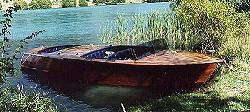
WOW! It's great! At last my boat is finished and I can enjoy it. As you can see from the photos it does everything just right. To catch up for you I started building my Riviera about 3 years ago and you have photos in Webletter no. 8 and owing to lack of money has taken this long to complete. The building was the easy and cheap bit. Not so the mechanicals. But anyway the boat has a Chev V8 350 with about 325 hp and a Borg Warner gearbox driving a 13 x 12 prop. The boat does about 50 mph and gets there real quick so I think I should play with the pitch. Any suggestions? Every thing on the boat is built by me so I've learned heaps. The boat is so unusual here in New Zealand that every time I take the boat out people just flock around feeling and touching it and putting dirty fingermarks on it. Bother! So many people have seen boats like this in movies but never in the flesh. The knowing ones who come for a look congratulate me on an excellent restoration and are blown away when I tell them it's brand new. I have named the boat ADDICTION which seems kind of fitting and congratulate you guys at Glen L for designing such a beautiful boat that any old mug with a little determination can build for himself. Beware though, boatbuilding is very addictive as in my head I am already working on boat number 3. This boat will be bigger and .... nah thats another story.
Regards
Wayne Cox sometimes boatbuilder
Site needs work
Subject: site needs work
Date: Wed, 7 Feb 2001 08:51:36 -0800
From: S. L.Your site is too hard and complicated . trying to find boat plans on race boats and end up with a migrane!
Going to Clark-Craft!!!!!!!!!!!!!!!!!!!!!!!
This is a rare email. Most visitors say things like "great site", "best on the web", and "your webmaster must be a genius"..... Well, I made up that last one. But I do think S.L. has a point. Are we getting too much on the site? Is there a better way to arrange it? Email your suggestions, they WILL be paid attention to. Most of the "Notes" pages in the "Boat Design Catalog" pages are in direct response to email questions. If I can find a better way to present our pages, I will do it. For those inclined to suggest that we need a shopping cart... it is in the works.
I would like to emphasize that we DO want your input. When I have asked for input in the past, I have gotten little or no feedback. Sometimes we are too close to the site and it takes an "outsider" to recognize the problems. To make a suggestion, click HERE.
Feedback: Sweet Caroline
Subject: Sea Trials - Sweet Caroline Dory/Skiff/Camper/Cruiser
Date: Wed, 28 Feb 2001 23:17:30 -0600
From: Don and Dianne
Well, today was the day!
If you were around in 1998-99 when I was casting about for a design to provide a "half-fast" (18-20 mph) minicruiser for a couple, I had ordered Tennessee plans from PB&F and erected a bow shelter to build it in (somehow Tennessee doesn't look like a "she"). Then I got cold feet and decided I just had to have a bit more speed and ruggedness. So I landed at Glen-L, ordered their "Sweet Caroline" 20-foot dory/skiff plans and noodled out my own accomodations and such.
After much dialogue and research, I concluded that this boat should hit my speed target with 25 hp, but more cold feet led me to select 40 hp to assure rapid planing and cruising at target speed and part throttle (3/4 throttle nominally). My only other real misgiving about the design was the flat bottom, which I thought might pound (my remaining teeth out) in a moderate chop.
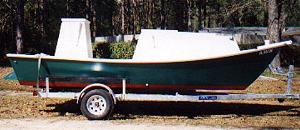
We launched her today and the results are in:
She is overpowered with a 40 hp Yamaha 2-stroke, achieving 30+ mph (GPS), 20 mph at I would say 1/2 throttle (I don't have a tach but I have run many 2-stroke outboards and it goes like this: it sounds like a fairly coherent machinery noise from idle to about 3000-3200 RPM, becomes harmonic from there to 4200-4500, and goes into that "on-the-tuned-exhaust" moan from 4500-5500.) I estimate 20 mph at 3200 RPM, to be confirmed when I get a tach.
It is a very strange feeling to have a 20 footer this fast on 40 hp - the ubiquitous 20 foot center console around here has at least 115 hp installed.
On the other hand, I can see why nobody sells a boat like this to the public. One should have some experience to avoid over-driving it in sizable chop - it will not stand up to leaping from wave to wave at 25+mph.
If you have seen the report on Kilburn Adams' "Skiff America 20", this boat is in the same performance box - KA claims 25 mph on a 25 hp 4-stroke, and I frankly was skeptical. I'm a believer now, but of course I'll keep my 40 and just underutilize it. Fuel mileage was disappointing, but may improve a bit with tweaking: 5 mpg for the 23 miles covered today during the 2-hour break-in regime... 10 minutes fast idle / 50 minutes NTE 1/2 throttle / 60 minutes NTE 3/4 throttle except 5 minute intervals of full throttle allowed. We (3 aboard) probably didn't spend 2 minutes at full throttle, because the boat is just too skittish above 24-25 mph, onset of "hobby-horsing" at about 27, saw 30 and just didn't want to stay there (the skipper, not the boat).
This is NOT a negative report, just commentary on the high-speed exploration. At 18-20 mph, this is a wonderful boat! It just slides smoothly from idle (3+mph) to hull speed (6.5-7.0 mph), an almost imperceptible little "bogging" move (stern goes down but you have to be looking for it to see or feel it - in fact I don't think I could feel it with my eyes closed) going toward 8 mph, then it is just like a FAST electric boat, going right up through 12, 15, 18, 20, then beginning to require closer attention to helm and avoiding huge wakes and such past 24 up to scary.
At these intended speeds, the engine is quiet, conversation continues, and it's just, er, genteel... conditions were 10 knot breeze, just beginning to white-cap on a 1-foot chop. None of the shattering pounding I remembered from the "old days" as a youth here (Florida Panhandle) when we all skittered about in 12-14 foot ply runabouts.
I think my biggest problem in making an itinerary will be the time spent with kibitzers, spectators, and such. People are just startled and intrigued by a boat this size that is totally unlike every other outboard around.
The flared sides and narrow (4 foot) bottom make her a little tender for a person stepping aboard on the side rail, must keep one hand free to steady before stepping further.
That's about it for first impressions, for you Fundyists it was almost 80 degrees F, we took a break for lunch and Coronas at a dockside cantina, and finished up with a recovery and relaunch for freshwater flush in the local reservoir lake at sunset. Now, to rework those splashing stern boarding steps, cut a foam blank into a main cabin mattress, and try to find out why my Garmin 12 died late in the day...
Don Hodges
www.ECoastLife.com
Designer's NotebookCB... What the heck is it anyway? CB is the abbreviation for "Center of Buoyancy" used on Glen-L plans. The CB can be compared to the fulcrum of an in-balance teeter-totter. The CB is the longitudinal balance point of the underwater volume. Add weight aft of the CB and the boat will go down by the stern, forward and it will be down at the bow. When the designer designs a boat of any size, he calculates the underwater volume, estimates the displacement, and determines the CB, however this initial figure is only a starting point. The weights of all the fixed components in the finished boat must actually be calculated. Yes, this means figuring the weight of each batten, gusset, keel, plank, plus everything in the boat including passengers, motor, etc. Hopefully, the total weight should be very close to the original displacement estimate. If not, the displacement must be re-figured to match the calculated weights and a new CB point determined. Now comes the fun. Each component part of the boat must have the location of its center of gravity measured relative to the CB; this is then multiplied by its weight. When finished, the designer has a long list including each part of the boat with the distance x weight listed; if the total of figures fore and aft the CB are equal, the hull is in balance. Obviously, this is seldom the case. When not, some weights must be shifted to bring the hull into balance. Although the weights of the components of the hull are fixed, some objects can be moved; fuel and water tanks are easily shifted and are usually the first choice of most homebuilders. But are tanks empty or full? Although designers use a half-full figure, due to the varying weight, the liquids are best located as close to the CB as possible. It isn't good practice to move passengers to balance the hull. Although the location of the helmsperson is usually fixed, it isn't practical to specify where each passenger must sit. It is simply a process of elimination to determine what can be shifted and how much. Back to our teeter-totter: the farther an object is from the CB, the more its weight affects the balance. A "weight-value" for each component is figured by multiplying the distance from the CB by its weight. A weight of 10 pounds 1' aft of the CB could be balanced by 2 lbs. 5' forward: 10 x 1 = 2 x 5. In extreme cases, the designer may find it necessary to alter the boat lines to shift the CB, however the options are limited by the parameters of the design. This, sometimes frustrating balancing act, is the reason many designers are gray haired or bald. Displacement or semi-displacement powerboats can be brought into trim by adding ballast. Balancing a sailboat can often be accomplished by moving existing ballast. However, as speed is a function of weight in planing boats, adding ballast for balance is undesirable. Fast planing powerboats are usually not designed to be in balance at rest. In a typical 10' outboard planning hull, the driver can often shift his weight forward to get the boat quickly on plane, then shift aft and the hull will be relatively level. Obviously shifting the driver forward far enough to have an effect in a larger boat is impractical. Outboards with power trim, afterplanes (cavitation plates) and similar appendages to lift the stern and bring the hull on plane more quickly. Any fixed appendage used to force the bow up or down causes resistance and detracts from performance. Open planing craft, such as deck boats with lots of passenger space, are only in balance with certain loading. The typical bow rider seems to invite everyone up forward but this imbalance becomes dangerous if carried to the extreme. For best performance, cruising type boats of any size will have superior performance if properly balanced about the CB. When balance is an important factor, our plans show the CB on the lines drawings. If you are thinking of adding extra fuel in that big open bow space, think again. What are you going to locate aft to balance the weight x distance contemplated forward? Keep the boat in balance for best performance. |
Feedback: Marauder
Wed, 7 Feb 2001
Yeh, there's a few of us lunatics over here as well (Ireland).
Started building the Marauder in Jan' 1995 - completed building frame and transom by end of Feb' but that was pretty much it for the rest of that year, the 'Day Job' got in the way. Each January since brought new enthusiasm and a 'Mad Bust' was made again for a month or so but it was really in February 2000 that we got down to business.
We are now nearing completion with just final finishes to do.
The building method is pretty much as per Glen-L but we did not use Fibre Glass on the outside - we used an Epoxy Resin finish by SP Systems and finished in Awlgrip - fantastic finish, way beyond expectations.
We also changed the internal layout, installing a full size Shower cubicle by encroaching into the main wheelhouse space, the top of which now serves as a chart table to the main wheelhouse. The mid-ships double stateroom was also 'inverted' so that your legs actually go under the internal Helm position - the additional space gained was given to the Vee-Berth Stateroom.
Our biggest deviation from the original design is that we have installed two water jets instead of prop's. This was mainly because my home port is tidal and I didn't fancy replacing props & shafts every other year ( boat handling expertise being inversely proportional to consumption of bottles of Bud - if ya know wot I mean ). How successful this will prove to be is yet to be seen but I received great help from Hamilton Jet and the Engineers at Mermaid Marine ( Engines ) so we are quietly confident.
To someone starting out I would say there is really only one mandatory requirement and that is a shed that you are not confined to a Time scale with, and is large enough and secure enough that you can walk away and leave your gear thrown about. If there is one thing that will stop you going to do some work it's the thought of having to run out power leads, get your power tools out etc, because by the time you're set up it's time to go home and you see no progress.
Everything else can be Begged, Stolen or Borrowed - believe me!
I had a professional survey done recently - purely for my own peace of mind - and have been informed that with some minor modifications we can achieve the same certification as a commercial or production craft.
We hope to launch in May of this year so I'll send an update closer to the date.
I couldn't help but notice that there is no other 'Marauder' in the project registry - surely we are not on our own?
Best Regards,
Brian Shanley.
Note: Surely Mr. Shanley is not the only one building the Marauder, but then, until this email we didn't know he was building it. Share information on your project with other builders.... they're waiting to hear from you.
Feedback: Kingpin
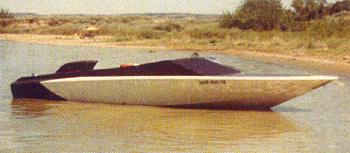
In response to your email of February 9, I have enclosed pictures of the Kingpin that I built in 1973 from one of your kits. I started it in March of 1973 and put it in the water in July. We didn't have seats, upholstery, or engine cover but we had to feel it run. We started out with a four-twenty six Hemi and a Berkley jet drive. It was a real screamer. I built the hull exactly as per plan and with your frame kit. We changed the foredeck from the daycruiser style to the style that is in the pictures. By fall we had the finish work done and pulled it down to Havasu.
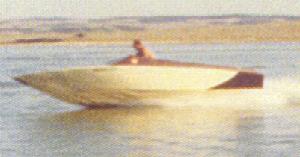
Every place we took it, we gathered a crowd. One trip in Wyoming, I had eighteen people aboard and pulled my son off the beach on his slalom. I got busted by a game warden for not having enough life jackets and he insisted that some of my people get on board his boat. The water got pretty rough and he was having a bad time, so I escorted him back to camp. He told me, after my time in court, "I sure wish we had boats like that!" It was the toughest, safest boat that I ever owned, I'm looking forward to paging thru your current catalog.
Thanks
Robert L Buenger
Cheyenne, WY
Feedback: Tubby Tug
Date: Fri, 9 Feb 2001
Tubby Tug / Willie and James Murphy / williemurphy@ls3p.com / 2/9/01 Started as father / son project June 1999 - Completed Oct 2000 Entered 11th Annual Wooden Boat Exhibit in Georgetown SC, 21 Oct 2000, winning People's Choice Award (Top honors out of 40 boats) Currently located in Charleston, SC, and will be on exhibit at Wooden Boat Appreciation Day in Charleston, 17 June 2001, and again at Wooden Boat Exhibit in Georgetown SC, 22 Oct 2001. Currently working on installing Motor, lights and CD player. We've had a blast working on this boat.
Barry,
Here are a few photos of Tubby.
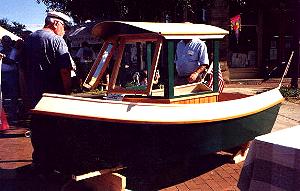
We worked in our garage. Power tools included a small table saw, biscuit joiner, orbital sander, drills, scroll saw, hand planes. There were times when a drill press, joiner, and a few other such tools would have been very helpful, but we made do with jigs, we set up for the tools we had. I found that using a very sharp hand saw was much faster than the jig saw, for cutting most of the plywood pieces. We cut everything just a little full, and trimmed with a small plane. I was very impressed with the full sized patterns and how well everything fit together.
Hull was made with marine grade plywood, and we used C & better fir (hand selected clear stock) for all the solid wood components. We used West Systems epoxy and glass cloth for joints. Hull is primed and painted with Interlux, Brightside Polyurethane "Sea green" and trimmed in "Grand Banks Beige". The cabin started as beige, but the green looked much better with the beige interior. We used clear spar varnish on all the wooden trim.
Recent email:
Subject: Guest Book entry
Date: Sun, 25 Feb 2001 05:27:03 -0700 (MST)
Name: Douglas Booth
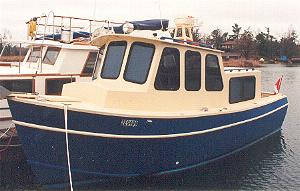
Comments: I have a Hercules class trawler (24') built in 1990. She is a fine sea going vessel and I use her extensively in the 1000 islands of the St. Lawrence River. She is a conversation piece at every dock I touch and a great Island hopper. Powered by a 20 horsepower Volvo Diesel she is also very fuel efficient.
Subject: Guest Book entry
Date: Sun, 28 Jan 2001 13:05:16 -0700 (MST)
------------------------------------------------------------------------
name: Mike Palenchar
Comments: Dear Sirs...
After reading Sail Magazine for years & reading your advertisement...I
decided to look at your web-site. It was great to see the pictures of all the
boats built with your plans & kits. Please know that in 1985 I completed
the 'Glen-L 17' sailboat. It took 3 years to complete. Wherever I
go...even when it's on the trailer, people look & rave about it. Of
course it's always kept in the garage...and I must tell you there has
'never been' anything but great performance from the design -
'never a failure' of any kind. Perhaps I'll send a picture or two
for your archives. Thanks for the site...
Subject: Guest Book entry
Date: Mon, 5 Feb 2001 00:52:19 -0700 (MST)
---------------------------------------------------------------------------
name: Nate Brown
Comments: I am building a Squirt with my son Derek, I own a boat repair shop and I am a professional Hydroplane driver. The fun my son and I are having building the boat is something that he will remember forever. I have built and repaired many boats and this one is great! I also aquired a Missle and it is in great shape, I will re-glass the deck and "fair up" a few things. I am going to power it with a 4.3 liter V6 and build a doghouse for it. I hope it will look as good as in my minds eye. Thanks for staying the same as I remember as a kid!
Subject: Guest Book entry
Date: Sat, 10 Feb 2001 20:30:01 -0700 (MST)
-------------------------------------------------------------------------
Name: Wendell Snider
Comments: In 1983 I launched "Driftwood", a 40' Mark Twain catamaran. You had her picture on your website for some time. I traveled on Driftwood for a period of 11 years by myself. Driftwood and I traveled on twenty some rivers in the midwest and southeast. We were through 130 different locks for a total of 538 lockages and logged 20,000 miles. She was a very rugged boat and survived some very trying times. I miss being on the rivers with her.
Subject: Guest Book entry
Date: Sun, 25 Feb 2001 21:18:44 -0700 (MST)
---------------------------------------------------------------------------
Name: John Ingle
Comments: I built one of your boats when I was about 28 I am now 68. I used
that boat for a long time & finally sold it. I am planning on building a
pontoon boat this summer & low and behold I found you on the internet.
It's been a long time, but hello again. John Ingle
PS I'll be ordering your Super Huck in a couple of months.
Subject: "The Fife"
Date: Mon, 5 Mar 2001
From: Jeffrey A. Brunot
Dear Glen-L folks:
I've been having so much fun constructing "The Fife". What a ball! Seems like everyday I get more people asking "when can we take it to the lake?".
The instructions are clear and easy to follow (even though this is my first time working with epoxy and resin putty). Wow how exciting.
Thank you for the good times.
Yours,
Jeff Brunot, Marietta, Ga
Build more boats
GLEN-L boats, of course